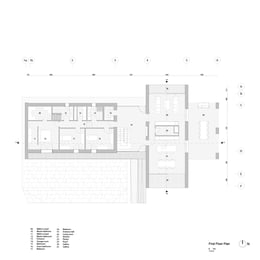Login
Registered users

The area in question is located in the municipality of Marano Vicentino (VI) on a sector on an undefined zone between the limits of the residential and the industrial area. The generating lines of the project start from the axes of the Roman centuriation to bring order to an area of lacking landscape quality in reference to the size and orientation of the lot. The main path of the garden is set on the vertical axis, while the residential zone, services and greenhouse are placed on the perpendicular axis. The new residential building will be constructed on the plot, which at present presents a slight slope on the part closest to the road on the north-south axis and on a difference in heigh of about 2.40 m from the east side close to the main road towards the west side bordering the production area. The new building, the result of the demolition and reconstruction of the existing one, will be a building consisting of two bodies arranged perpendicularly to each other and articulated on two levels, characterizing a single building unit. The ground floor of the new dwelling will be set on the original elevation of the ground floor of the existing residence to ensure the preservation of the current conformation of the land. The first floor accommodates all the rooms that make up the living area and the sleeping area, connected by the entrance hallway which overlooks a small guest bathroom. The living area, located in the east body, is made up of a large room that includes a pantry, a living room and a kitchen, both with direct access to the garden on the first-floor level through two loggias and a porch. The roofing will be of two types: pitched roof, as regards the volume of the living area. The ventilated type with the same exterior finish as the walls, it will also house photovoltaic panels of the extensive green type. As regards the body of the sleeping area and the east portico. The facades will have three different finishes. On the ground floor, the finishes will be mainly plastered. On the first floor, the north and south fronts of the sleeping area will have a stone clad façade; the west front will instead be plastered. In order to eliminate the environmental impact of the new building, the project's approach is based on biophilic methods with a particular focus on the verification of energy needs with the aim of producing more energy than is strictly necessary. The aim is to create an energy community by networking the surplus energy with the neighborhood in a logic of creating and sharing production through renewable sources, completely eliminating those of fossil origin, the cause of the ongoing climate change.





















The VSassociati studio was founded in 1992 by architects Fabrizio Volpato and Giorgio Strappazzon.
Since its foundation, the studio has been oriented towards technological innovation and sustainability; this approach is evident both in new projects and in interventions related to the renovation of existing buildings, particularly in the restoration of bound goods defined as artistic and cultural heritage.
Today the firm's research is increasingly directed towards the off-grid, literally grid less, through experimentation with self-sufficient and sustainable building management solutions.
Since 2000 the firm has been working under a Quality System according to UNI EN ISO 9001 and in 2008 obtained the ETICA SA 8000 Certification, maturing important research and experience in the field of bio-architecture for both public and private buildings.
http://www.studiovsassociati.i...